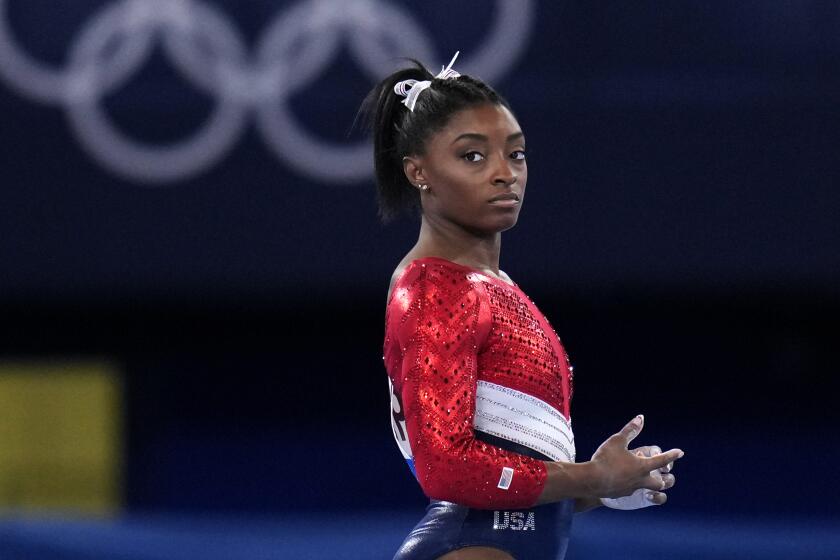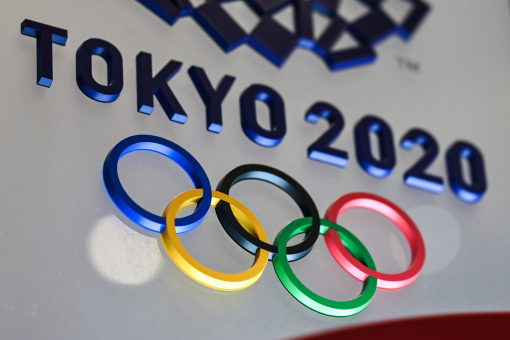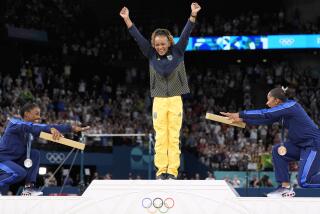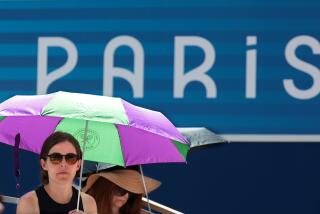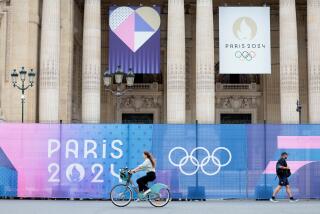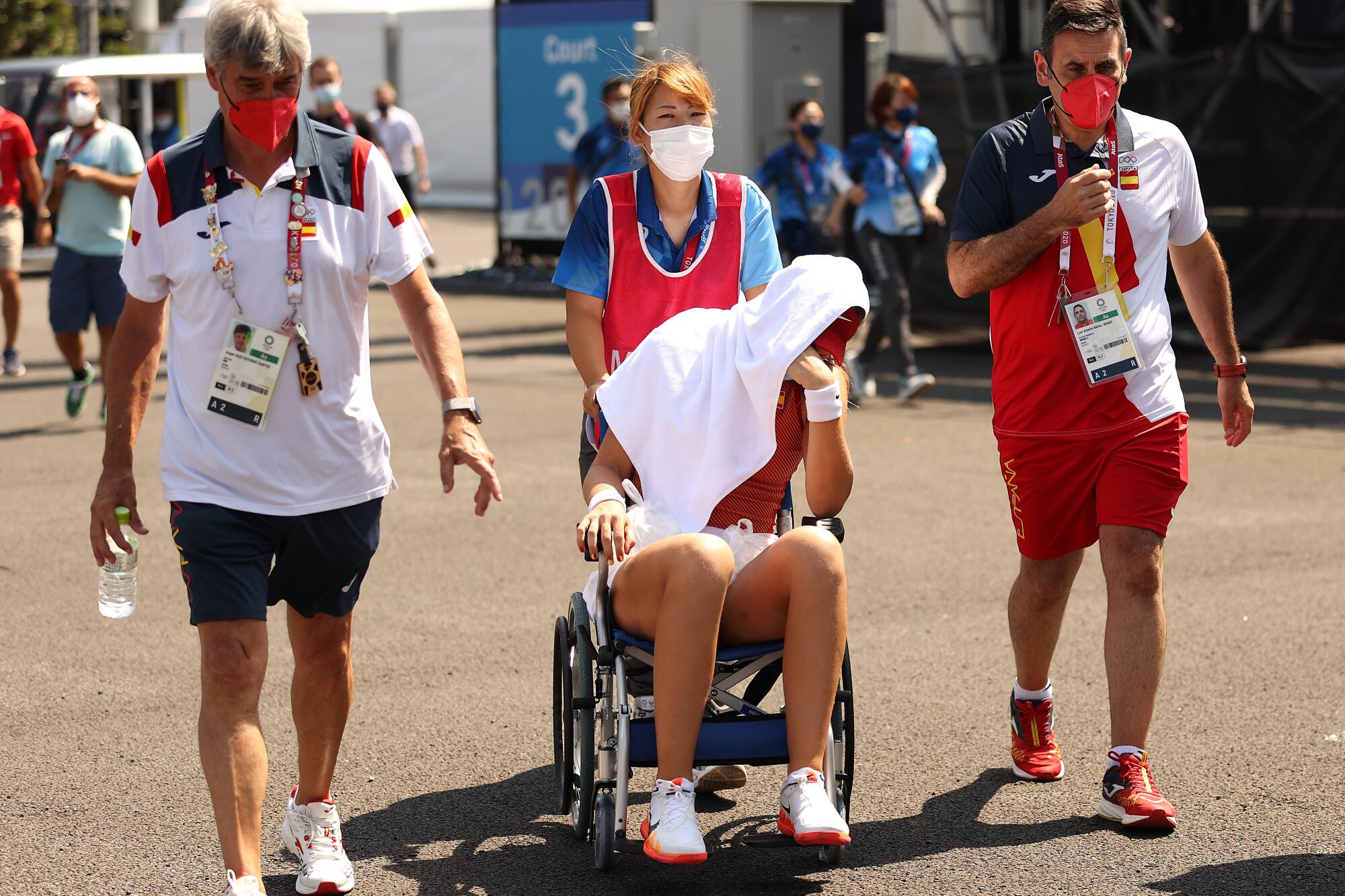
- Share via
TOKYO — It wasn’t just the unrelenting sun. Or the sluggish air, wet and still and settling close to the ground.
By midday the canoe slalom course at the Summer Olympics, a man-made rapids beside Tokyo Bay, had been transformed into something that left racers sweating and exhausted after barely a minute, as if its churning waters had been brought to a boil.
“It’s like a bath,” Matej Benus of Slovakia said. “It’s like paddling in bathwater.”
These Games figured to be among the hottest in Olympic history, and other than a few days when a tropical cyclone blew through, they have not disappointed. Beach volleyball has felt like a sauna, and tennis courts have turned into frying pans, with one player carted away in a wheelchair and another reportedly asking the umpire: “If I die, are you going to be responsible?”
Simone Biles, who withdrew from the team and all-around gymnastics finals, will not compete in two apparatus events at the Tokyo Olympics on Sunday.
Conditions at the equestrian center in the heart of the city have been fit for neither man nor beast.
“I felt it more for my horse,” said Kelly Layne, an Australian rider. “I felt like he was feeling it.”
Temperatures in the high 80s with humidity around 76% is common to Tokyo at this time of year. As recently as the summer of 2019, dozens of people died and thousands more were hospitalized during a heatwave. The unkind climate is caused by factors both natural and not.
High pressure over the Pacific Ocean each summer causes water vapor to be carried to Japan by southerly winds. This dynamic is multiplied by a phenomenon known as the “Urban Heat Island effect.”
An estimated 15,000 miles of roadway in this metropolis absorb and hold warmth. Countless buildings block airflow that might otherwise cool the days and nights. Like all big cities, Tokyo is significantly warmer than surrounding areas.
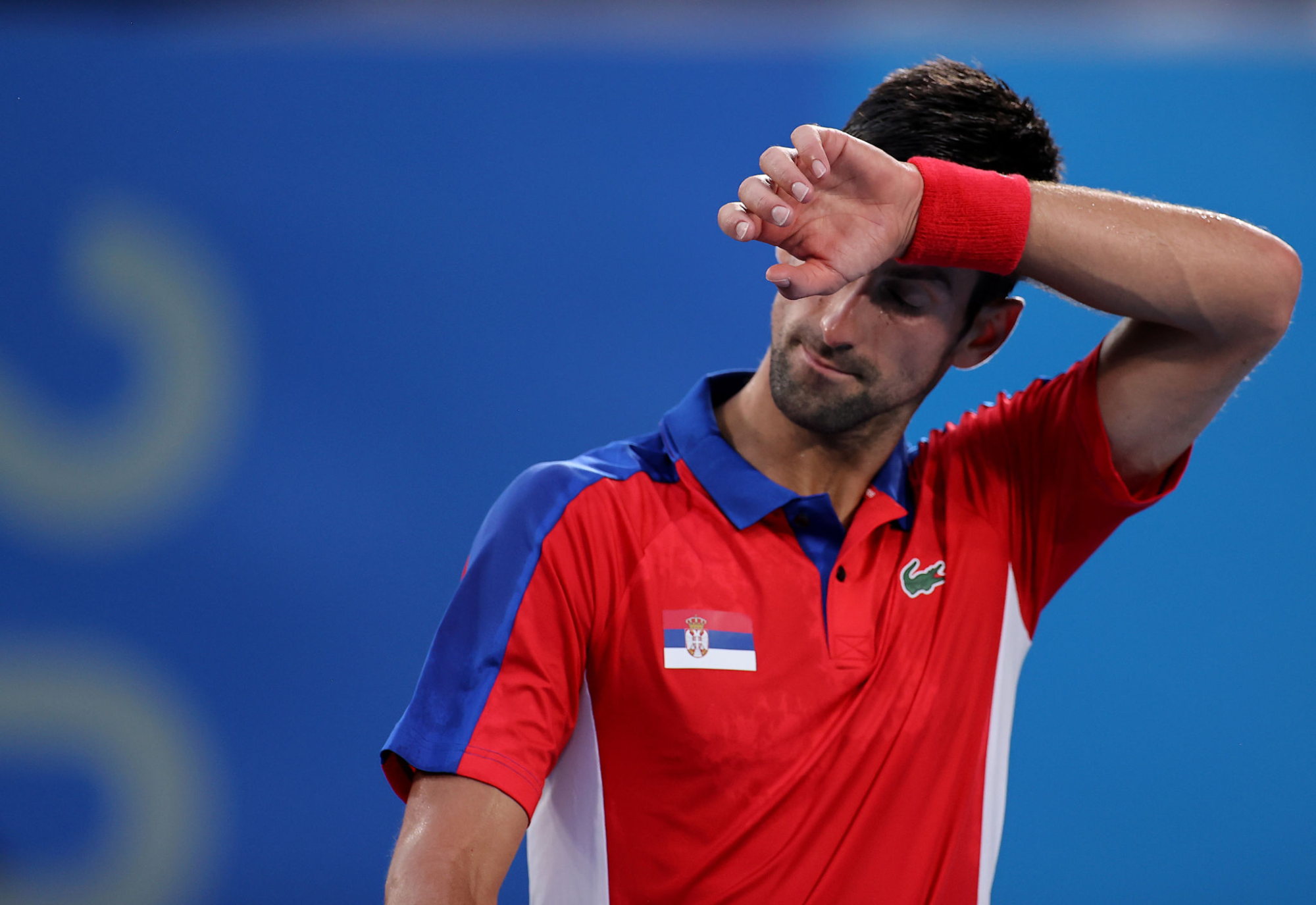
“The conditions are really brutal. I’ve played tennis now professionally for 20 years and I’ve never faced this kind of conditions.”
— Novak Djokovic, on the heat in Tokyo
During last summer — when the Games were scheduled to be held but were postponed because of COVID-19 — the weather was uncharacteristically cool. No such luck this year.
“If you’re not acclimatized, heat-related illness is a life-threatening condition,” said Dr. Jonathan Finnoff, chief medical officer for the U.S. Olympic & Paralympic Committee. “It is serious from a health point and performance standpoint.”
In the years leading up to the Games, local organizers pondered repaving streets along the original marathon route with heat-shielding materials and letting curbside trees grow shaggy for more shade. Concerned about fan safety, they explored the idea of blowing man-made snow over the stands.
Part of their dilemma was solved when they barred spectators because of the pandemic. But there were still athletes to worry about.
Like other national Olympic teams, the Australians arrived with a game plan devised by its “Tokyo Heat Group” of scientists and physiologists.
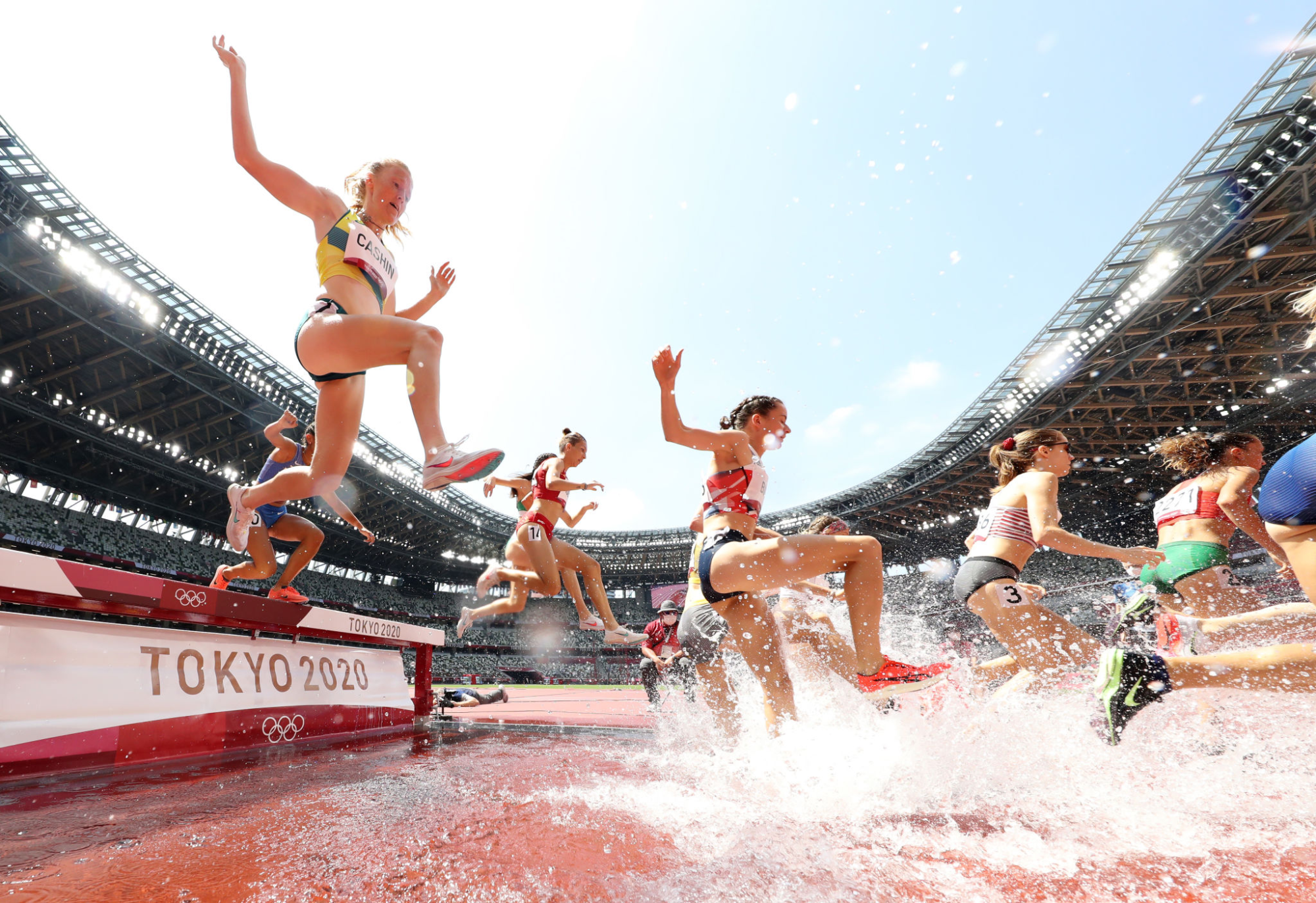
“Sometimes with all the understandable focus on COVID, we can lose sight of the fact that heat duress has been front and center of a lot of our concerns around health,” said David Hughes, the team’s chief medical officer. “But I can assure you that … we haven’t taken our focus off the heat.”
Ice-packed vests have become a common sight at outdoor venues, competitors pulling them on as soon as they exit the field of play. Neck coolers and air-conditioned locker rooms have become invaluable as organizers hand out powdered drinks meant to combat dehydration.
On a larger scale, International Olympic Committee executives had grown particularly concerned after the 2019 world track and field championships in Doha, Qatar, where 28 of 68 starters in the women’s marathon dropped out even though the race was held at midnight.
To the consternation of the Japanese, the IOC shifted the marathon and race walking 500 miles north to Sapporo, a move that could knock 10 degrees off expected temperatures. Other competitions were scheduled in the mornings and evenings when possible, and heat breaks were built into various events.
As athletes began arriving in Japan, organizers said they were coordinating with the Japanese Meteorological Agency to anticipate severe weather. They got a break last week when Tropical Storm Nepartak missed Tokyo to the north, delivering showers that cooled things off for a few days.
Still, conditions have been harsh on the courts of Ariake Tennis Park. Paula Badosa of Spain could not finish her quarterfinal match, and Russian player Daniil Medvedev complained to the umpire.
Novak Djokovic, the world’s No. 1 player and recent Wimbledon champion, kept up pressure on officials to make a change.
“The conditions are really brutal,” he said, adding: “I’ve played tennis now professionally for 20 years and I’ve never faced this kind of conditions.”
Hours later, the international tennis federation decided to shift the remainder of its midday matches to early evening.
At the nearby Ariake Urban Sports Park, skateboarders in the street contest retreated under umbrellas between runs.
“The sun, definitely, it does affect your trucks,” Manny Santiago of Puerto Rico said of the axles on his board. “It affects your shoes, it affects the way your feet feel inside your shoes because they’re sweaty — a lot more sweatier than normal.”
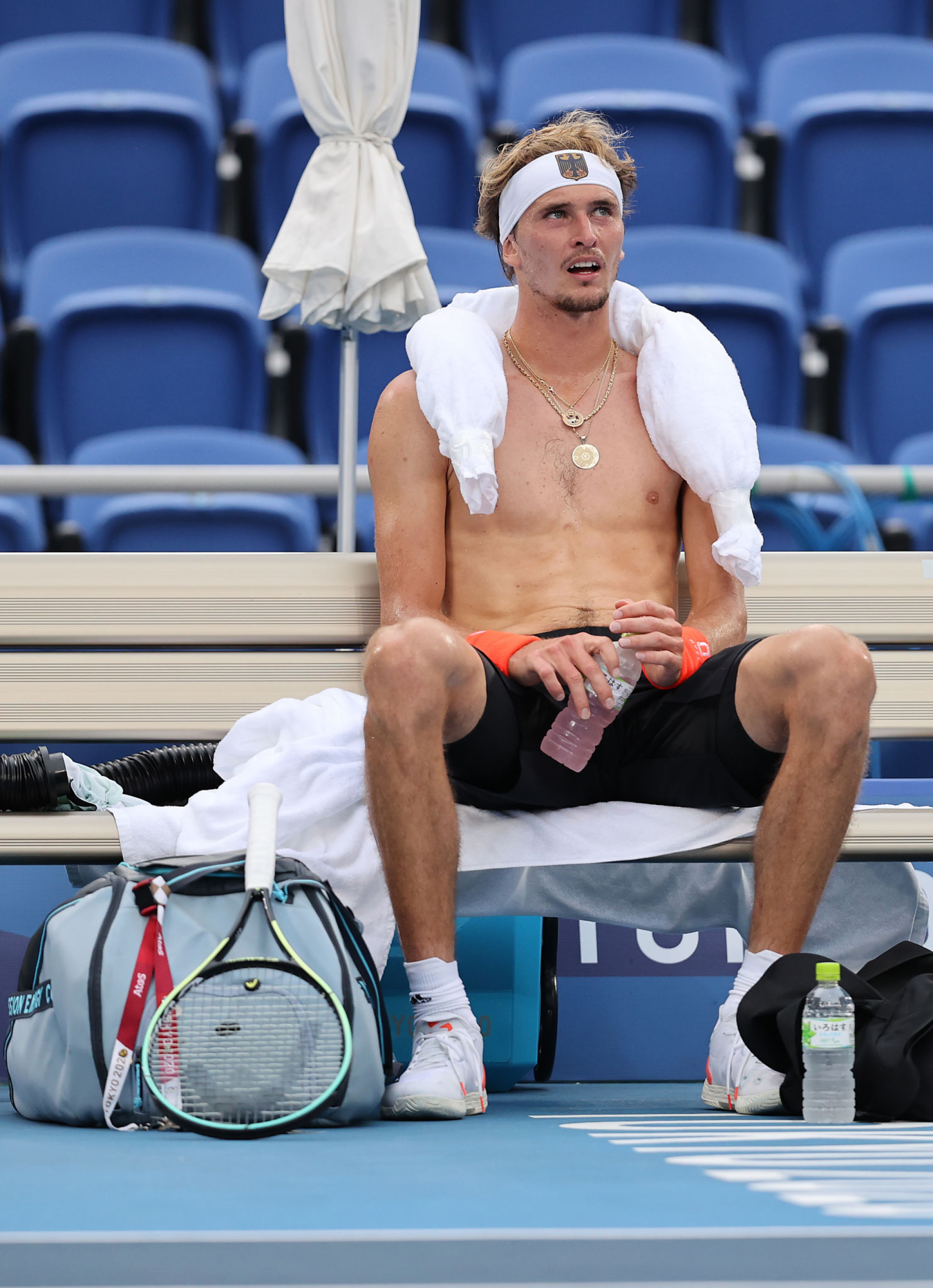
U.S. beach volleyball player April Ross explained that she and partner Alix Klineman had trained in a sauna to prepare for Tokyo. Russian shooter Alexey Alipov said he never encountered anything like these conditions during the men’s trap event.
“This is the first time that I have had streams of sweat, quite literally, that I had to wipe off each three, four shots and sometimes two,” he said after finishing eighth in men’s trap. “I had to take my glasses off and wipe off the sweat.”
Not everyone was walking into an unfamiliar climate. Some members of the U.S. women’s soccer team suggested that Japan did not feel much different from summertime matches they played in Kansas City, Houston and North Carolina.
“Hey, man, I grew up in Daytona Beach,” said Perry Baker, a wing on the men’s rugby team. “If you know anything about Florida, it’s super hot and humid there.”
But even athletes competing in or on the water found Tokyo uncomfortable. Much like the canoeists, open-water swimmers worried about the ocean temperature at Odaiba Marine Park.
New Zealand swimmers, when not inside the Tokyo Aquatics Center, have taken a page from the 7-Eleven playbook. Sipping from a cup, Lewis Clareburt explained to the media that they had taken to drinking slushies.
More to Read
Go beyond the scoreboard
Get the latest on L.A.'s teams in the daily Sports Report newsletter.
You may occasionally receive promotional content from the Los Angeles Times.

